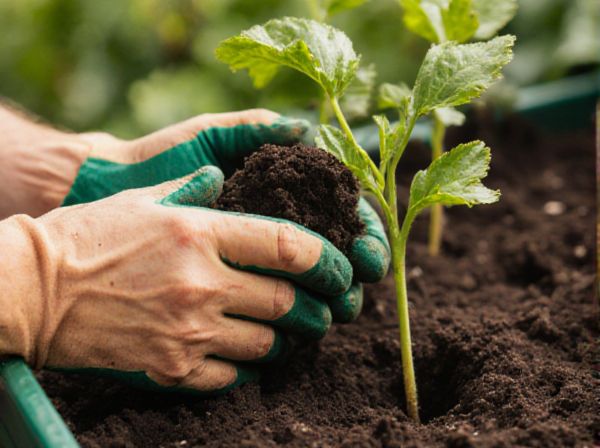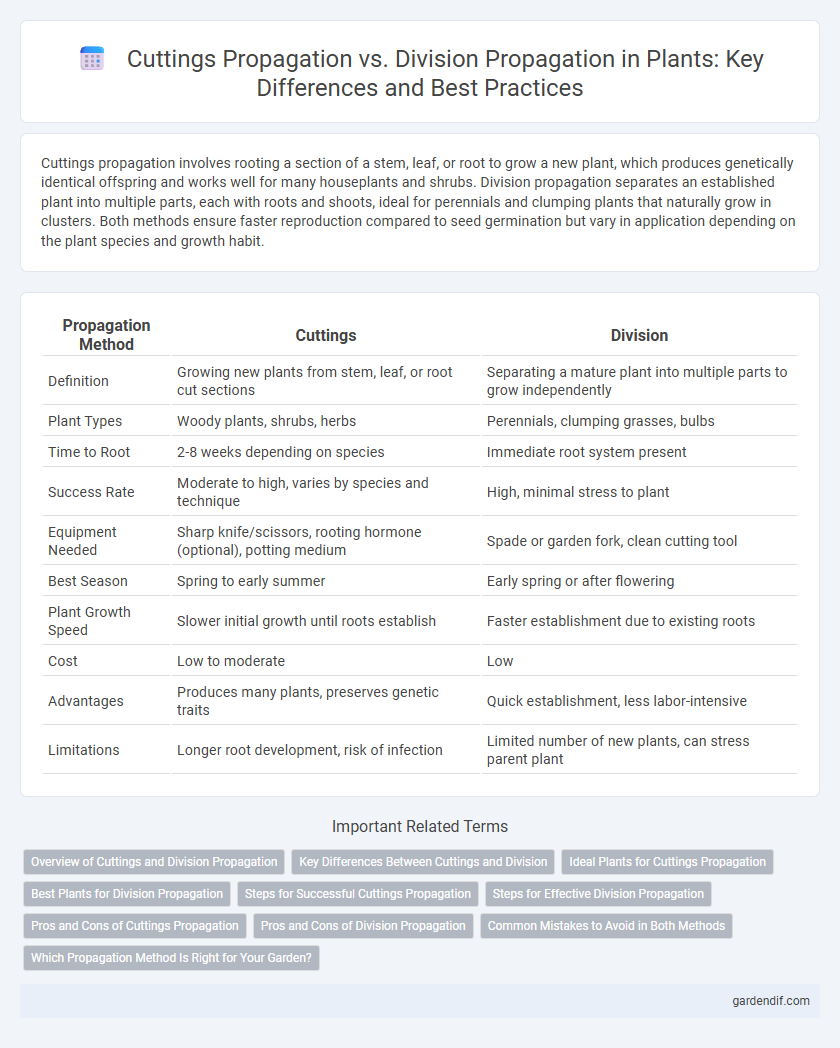
Cuttings propagation vs Division propagation Illustration
Cuttings propagation involves rooting a section of a stem, leaf, or root to grow a new plant, which produces genetically identical offspring and works well for many houseplants and shrubs. Division propagation separates an established plant into multiple parts, each with roots and shoots, ideal for perennials and clumping plants that naturally grow in clusters. Both methods ensure faster reproduction compared to seed germination but vary in application depending on the plant species and growth habit.
Table of Comparison
| Propagation Method | Cuttings | Division |
|---|---|---|
| Definition | Growing new plants from stem, leaf, or root cut sections | Separating a mature plant into multiple parts to grow independently |
| Plant Types | Woody plants, shrubs, herbs | Perennials, clumping grasses, bulbs |
| Time to Root | 2-8 weeks depending on species | Immediate root system present |
| Success Rate | Moderate to high, varies by species and technique | High, minimal stress to plant |
| Equipment Needed | Sharp knife/scissors, rooting hormone (optional), potting medium | Spade or garden fork, clean cutting tool |
| Best Season | Spring to early summer | Early spring or after flowering |
| Plant Growth Speed | Slower initial growth until roots establish | Faster establishment due to existing roots |
| Cost | Low to moderate | Low |
| Advantages | Produces many plants, preserves genetic traits | Quick establishment, less labor-intensive |
| Limitations | Longer root development, risk of infection | Limited number of new plants, can stress parent plant |
Overview of Cuttings and Division Propagation
Cuttings propagation involves rooting segments of stems, leaves, or roots to produce new plants genetically identical to the parent, commonly used for shrubs, succulents, and herbaceous plants. Division propagation separates a mature plant into several parts, each with roots and shoots, ideal for clumping perennials and bulbs to ensure rapid establishment. Both methods bypass seed germination, offering faster reproduction and maintaining genetic traits for horticultural consistency.
Key Differences Between Cuttings and Division
Cuttings propagation involves rooting a portion of a plant, such as a stem, leaf, or root segment, to grow a new plant genetically identical to the parent. Division propagation separates an established plant into multiple smaller plants, each with its own roots and shoots, suitable for species with clumping growth habits like hostas or irises. While cuttings require careful environmental control to encourage root development, division is a quicker method that relies on separating mature plants without the need for rooting hormones or extended care.
Ideal Plants for Cuttings Propagation
Ideal plants for cuttings propagation often include herbs like basil, mint, and rosemary due to their fast-growing stems that root easily. Succulents such as jade plants and echeveria also respond well to stem cuttings because their water-storing tissues reduce dehydration risks. Woody shrubs like hibiscus and hydrangea benefit from semi-hardwood cuttings that establish roots quickly under controlled humidity and temperature.
Best Plants for Division Propagation
Division propagation works best for perennial plants such as hostas, daylilies, and irises, which naturally form clumps or rhizomes that can be separated. Unlike cuttings propagation that relies on stem or leaf segments, division involves splitting established plants into smaller sections with roots attached to ensure successful growth. This method accelerates maturity and flowering since each division is essentially a mini-mature plant.
Steps for Successful Cuttings Propagation
Cuttings propagation involves selecting healthy stem or leaf segments, making clean cuts just below a node, and placing them in a moist growing medium to encourage root development. Maintaining consistent humidity and temperature, along with the use of rooting hormones, significantly improves success rates. Regular monitoring for root growth and transplanting once established ensures robust plant propagation.
Steps for Effective Division Propagation
Division propagation involves carefully separating a mature plant into multiple sections, each with its own roots and shoots, to create new plants. Begin by gently removing the plant from its pot or ground, then use a sharp, sterile knife or hands to divide the root ball into smaller clumps, ensuring each division has healthy roots and stems. After division, replant the sections in well-draining soil, water thoroughly, and place them in a shaded area to reduce stress and promote successful establishment.
Pros and Cons of Cuttings Propagation
Cuttings propagation offers the advantage of producing genetically identical plants quickly, ensuring consistency in traits like flower color and growth habit. This method requires less space and fewer resources compared to division propagation, making it cost-effective for propagating large numbers of plants. However, cuttings are more susceptible to diseases and environmental stress during rooting, and some species do not root easily, limiting their effectiveness for certain plants.
Pros and Cons of Division Propagation
Division propagation enables the rapid multiplication of mature plants by separating root clumps, ensuring genetic consistency and immediate flowering potential. However, it can be stressful to plants with delicate root systems and may cause temporary growth setbacks due to root disturbance. This method suits perennial herbs and grasses but is less effective for plants that do not naturally form clumps or rhizomes.
Common Mistakes to Avoid in Both Methods
Cuttings propagation often fails due to insufficient moisture control and using non-sterile tools, leading to fungal infections. In division propagation, common errors include damaging root systems and dividing plants during dormancy, which can stress the plant and reduce survival rates. Ensuring proper timing, clean equipment, and gentle handling are critical to successful propagation in both methods.
Which Propagation Method Is Right for Your Garden?
Cuttings propagation involves rooting sections of stem, leaf, or root to produce genetically identical plants, making it ideal for preserving specific plant traits and rapidly multiplying desired varieties. Division propagation separates established clumps or root systems, best suited for mature, clumping perennials like hostas and daylilies, promoting vigorous growth and rejuvenation. Selecting the right method depends on the plant species, growth habit, and desired propagation speed to ensure healthy, successful garden expansion.
Cuttings propagation vs Division propagation Infographic

 gardendif.com
gardendif.com